"Non-Arab Emirates": migrants in the Gulf countries
The fact is that if in some European countries migrants make up 10% of the population, then in the Gulf countries the number of foreign labor migrants can reach half or even two-thirds of the total number of inhabitants. So, in Saudi Arabia, foreign citizens make up from 20 to 30% of the population, in Kuwait - over 50% of the population, in Qatar - about 80%, in the United Arab Emirates - up to 90% of the population. These figures are extremely impressive and make you think that in European countries, in terms of control over the migration situation, all is not lost. Unlike Europe, the oil states of the Arabian Peninsula without foreign labor simply cannot survive. Indeed, without a workforce - even a significant part of the armed forces of the same Oman or Qatar are mercenaries - people from India and Pakistan.
Oil and migration processes
Until the second half of the twentieth century. The Arab monarchies of the Persian Gulf were extremely socio-economically backward countries, with conserved medieval orders. Most of the population of these countries lived in poverty, their lifestyles have remained virtually unchanged since the Middle Ages, and the modern social, economic, and communication infrastructure has been in its infancy. The situation has changed thanks to the beginning of active exploitation of oil fields, as a result of which the kingdoms and emirates of the Persian Gulf received an incentive for rapid economic development and made an almost lightning "leap into the future." However, the growth of wealth due to high oil revenues, which allowed the creation of modern infrastructure, did not entail major changes in the socio-cultural sphere of life of the Gulf States. They still remain feudal monarchies, in which the role of Islam and local tribal traditions is extremely high. But the preservation of the social order inevitably entails a number of negative trends, and the first among them is the consolidation of the specific psychology of the local population.
By the time the oil fields began to be developed, the vast majority of the population of the monarchies of the Persian Gulf led the traditional way of life, engaging in nomadic and semi-nomadic herding, at best, in primitive farming in oases. However, rapid economic growth after the start of exploitation of oil fields sharply increased the level of welfare not only of sheikhs and emirs, who turned into world-class multimillionaires, but also affected the material well-being of ordinary representatives of local Bedouin tribes. The indigenous Arab population of the Persian Gulf monarchies received numerous social benefits, allowing them to choose the most prestigious and least labor-intensive professions. The lack of the necessary qualifications almost immediately excluded the possibility of using local labor in the oil and construction business. On the other hand, the locally unqualified citizens didn’t strive to perform non-prestigious work, because, firstly, it was not very well paid, and secondly, and more importantly, it didn’t meet the traditional ideas about acceptable activities for a Bedouin man. As a result, the majority of vacancies and highly qualified specialists, and skilled workers, and attendants began to be filled by foreign employees.
The economic growth of the Gulf countries contributed to the constant opening of new vacancies, which entailed the need for further import of labor from other countries. Foreign experts of high qualification from the USA and countries of Western Europe became a separate group, which we practically will not consider in this article. The development of oil production entailed the need for engineers with specialized education, competent managers who were invited from Western countries on very favorable terms. Subsequently, highly qualified specialists from Western countries appeared in almost all sectors of the life of the countries of the Persian Gulf. Only in the UAE, according to sociologists, no less than 70 of thousands of European and American highly qualified specialists of various profiles work. But Western specialists are a special category, a privileged one. The main part of the migrants are immigrants from Asia and Africa, who are the basic labor force in the countries of the Persian Gulf.
Ethnic panorama of migrants
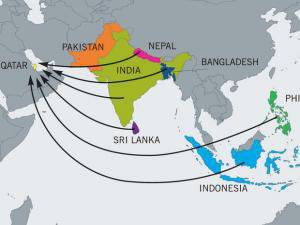 In 1970 - 1980 - s. The main part of labor immigrants in the Gulf countries were Arabs - immigrants from Yemen, Iraq, Syria, Egypt, Algeria, Sudan, Palestine, as well as immigrants from Iran. The attitude towards them has always been more or less tolerable due to the closeness of cultures. However, later on, the authorities of the Gulf monarchies began to take restrictive measures, primarily related to concerns about political loyalty of immigrants arriving from neighboring Arab countries. After all, the majority of immigrants arrived from countries with questionable, from the point of view of the monarchies of the Persian Gulf, secular political regimes - from Iraq, Syria, Egypt, Sudan, Algeria, Yemen, from the warring Palestine. Many of them were politicized and were supporters of various versions of Arab socialism, which in itself could already be considered as a riskogenic factor in their presence on the territory of the Gulf countries.
In 1970 - 1980 - s. The main part of labor immigrants in the Gulf countries were Arabs - immigrants from Yemen, Iraq, Syria, Egypt, Algeria, Sudan, Palestine, as well as immigrants from Iran. The attitude towards them has always been more or less tolerable due to the closeness of cultures. However, later on, the authorities of the Gulf monarchies began to take restrictive measures, primarily related to concerns about political loyalty of immigrants arriving from neighboring Arab countries. After all, the majority of immigrants arrived from countries with questionable, from the point of view of the monarchies of the Persian Gulf, secular political regimes - from Iraq, Syria, Egypt, Sudan, Algeria, Yemen, from the warring Palestine. Many of them were politicized and were supporters of various versions of Arab socialism, which in itself could already be considered as a riskogenic factor in their presence on the territory of the Gulf countries. People from Arab countries who did not have a language barrier with the local population could have had an ideological influence on the latter, as well as more firmly and resolutely defended their own interests before the leadership of state structures and private companies. But the greatest danger, of course, was that the leaders of the Persian Gulf countries saw the spread of socialist and republican ideology in their states, especially since they had an example of North and South Yemen, in which, overwhelmingly not without the support of Egypt, the local feudal monarchies and establishment of republican regimes. Moreover, pro-Soviet forces came to power in South Yemen (People’s Republic of South Yemen). Therefore, gradually the governments of the Gulf countries began to restrict migration from other Arab states, as well as to arrest or deport unreliable, in their view, Arab immigrants.
Currently, the main labor resource used in the countries of the Persian Gulf are immigrants from India, Pakistan, Bangladesh, Nepal, the Philippines, as well as a number of East African states - Ethiopia, Eritrea, Somalia. The birth rate in these countries is extremely high and all of them, to varying degrees, have problems with overpopulation and employment of a growing population. Unemployed youth and older people in search of earnings go to the countries of the Persian Gulf, where they constitute the vast majority of workers in all industries, service personnel in hotels and tourist complexes, and lower and middle-level specialists.
Currently, at least 65% of the total number of foreign workers in the Gulf countries are from India, Pakistan, Bangladesh, the Philippines, Sri Lanka, Nepal, Indonesia. In particular, at least 5 million of Indian citizens, 2 million of immigrants from Pakistan, 1,5 million of immigrants from Bangladesh constantly work there. The Diaspora of Filipino migrants is very significant in numbers. Up to 90% of people from the Philippines goes to work in the countries of the Persian Gulf. Filipino migrants are considered good and sought-after workers because of their high performance and skills, unlike less skilled Bangladeshis or Indonesians. The government of the Philippines seeks to regulate relations between its citizens, who work in Arab countries, and employers, which has repeatedly led to conflict situations, especially with regard to the fact that private companies in the Persian Gulf countries respect the labor rights of Philippine citizens.
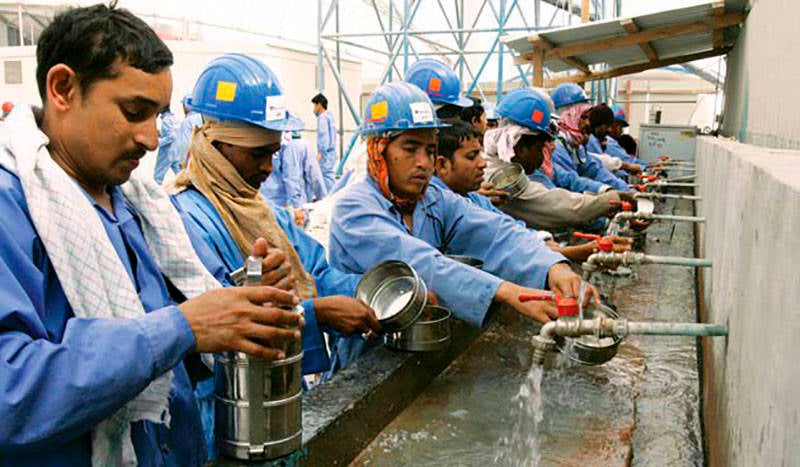
The rest of the foreign labor migrants account for, for the most part, immigrants from Arab and African countries. The most numerous come from Egypt, Jordan, Palestine. It should be noted that the ethnic composition of labor migrants in the Gulf region may vary, depending on the country. The general trend is a gradual decline in the number of Arab immigrants in all countries of the Persian Gulf - people from South and Southeast Asia dominate the regional labor market for a long time. In Oman and Bahrain, Arabs constitute an absolute minority in the total number of labor migrants - their numbers do not exceed 10%. The situation is slightly different in Saudi Arabia, Kuwait and Qatar, where the proportion of Arabs still remains within 20-38% of the total number of labor migrants (Skopich OA Problems of labor migration in the Persian Gulf // http: //www.iimes. com / rus / stat / 2007 / 10-09-07.htm).
In the past two decades, the number of migrants from the republics of Central Asia has gradually increased, primarily from Uzbekistan and Tajikistan. However, their number against the background of South Asian, Arab and African migrants in the countries of the Persian Gulf is still extremely insignificant and is unlikely to seriously affect the social situation in the considered countries.
As for the areas of employment of migrants, the labor market in the Gulf countries has long found their ethnic niches. For example, in Saudi Arabia, the bulk of domestic workers and nurses are women who come from Indonesia, Sri Lanka and the Philippines. In the tourism industry, more than three quarters of workers are from South and Southeast Asia. In the UAE, foreign citizens, mainly Indians and Pakistanis, are busy with almost all the vacancies of private companies in the field of construction, consumer services, tourism, and retail.
In a number of Gulf countries, foreigners not only make up the vast majority of employees of private companies, but also play an important role in business, being the owners of many enterprises and firms. Moreover, this is not about specialists from Western Europe and the USA, but about immigrants from other Arab states, Iran, India and Pakistan. Thus, the large role of the Indian community in the economy of Oman is due to long-standing historical connections between the coast of Western India and Oman, which were established in the Middle Ages. The same goes for the Persian community in Bahrain. Perhaps, at the very bottom of the social hierarchy of the Gulf countries are immigrants from East Africa. Ethiopians, Eritreans, Somalis have an even lower standard of living than Indian, Pakistani and Bangladeshi workers. The bulk of Africans are unskilled workers. Often it is they who replenish the local marginal strata, are involved in criminal activity.
Attempts to solve the problem
The predominance of labor migrants in the total number of employees in the Gulf countries actually put them in complete dependence on foreign labor. Today, the economy of a single state in question cannot do without foreign workers. This fact completely rejects any possibility of "ridding" the Arab states of the Persian Gulf from foreign migrants and puts them in the inevitable prospect of losing their national identity in a relatively near future. From the complete transformation of Arab countries into non-Arab, the monarchies of the Persian Gulf are so far saved only by a tough domestic policy of the ruling regimes, including strict control over foreign nationals located in the countries of the region.
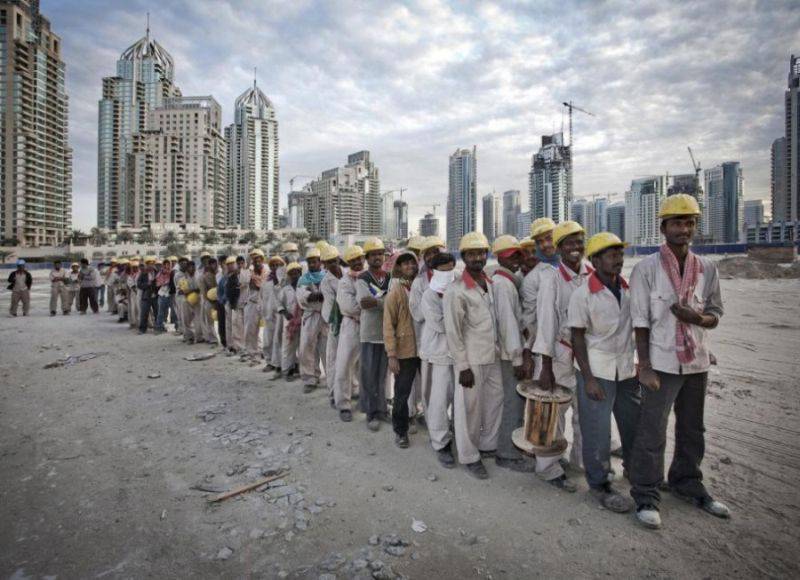
First of all, the countries of the Persian Gulf support the existing segregation of the local population and migrants. Foreigners are settled in special quarters, under the supervision of police departments. Any breach of labor discipline, not to mention offenses, means for immigrants immediate expulsion from the country that accepted it. Segregation of migrants and the local population is also supported by differences in wage levels. Representatives of the indigenous population receive higher salaries, which emphasizes the superiority of their social status over foreign workers. However, this same factor creates many additional problems for the Gulf countries. First, the wage gap encourages private company owners and individual employers to expand foreign labor mobilization, since its use appears to be economically viable. Secondly, social polarization contributes to the growth of the conflict-prone potential of the migrant environment, since many foreign workers, staying for years and even decades in the territory of the Gulf countries, inevitably wonder why they receive less money and are virtually deprived of the opportunity to protect their labor rights.
In addition to the segregation of migrants and strict control over the observance of local laws and customs, the violation of which is punished at best by instant deportation, the governments of the Gulf countries in recent years have sought to implement programs to increase the proportion of indigenous people in all sectors of the economy. They were prompted to this decision, including the dissatisfaction of local residents, especially young people, with the domination of foreign workers, in connection with which the indigenous population cannot be employed.
So, in Saudi Arabia since the 1990-s. The policy of “Saudization” of various sectors of the economy is being implemented. As early as 1997, private companies were ordered to annually employ a certain number of Saudi citizens and vacate foreign migrant positions for the latter. In turn, law enforcement agencies of Saudi Arabia are engaged in catching and deportation of illegal migrants. In the UAE, the “nationalization of personnel” program is aimed at gradually recruiting almost all the posts (90-95%) in government institutions, the overwhelming majority (80%) of posts in economic institutions, and more than half of the posts (60%) in police and security agencies .
However, the government’s plans for “nationalization of personnel” are good in the form of projects, but in reality they quickly face the realities of local labor markets. First, among the indigenous population, including its younger generation, there are very few qualified specialists in the sought-after professions, and, as mentioned above, local residents do not want to occupy because of their lack of prestige and low wages. Secondly, it is also unprofitable for private companies to hire local residents, who will have to pay higher wages, respect their labor rights, and local residents will work worse and less disciplined. It turns out a closed situation. So far in the countries of the Persian Gulf, it is possible to fill in representatives of the local population only civil service posts, primarily in administrative institutions, the armed forces, and law enforcement agencies. Private companies are still gaining foreign labor. They are not in a position to refuse it, and not only for the reasons mentioned above - the number of indigenous people in the Gulf countries is low and companies simply cannot meet the need for employees exclusively at the expense of representatives of the local population. Thus, the Persian Gulf countries are not able to get out of the closed situation and are unlikely to succeed.
Meanwhile, the presence of a significant contingent of foreign migrants, despite the incomparably tougher, as compared with the countries of Europe, legislation and law enforcement practice, creates in the Gulf countries a lot of problems similar to those experienced by Europe today. This includes the growth of crime, the emergence of enclaves, and the increase in social tension in society, and the spread of radical and extremist sentiments among migrants. The most actively trying to solve the problem of migration is Saudi Arabia, the largest and most powerful state in the region, with authority throughout the Islamic world. In Saudi Arabia, the country's population is 28 million, while there are more than 9 million migrants in the kingdom. The presence of so many migrants, the overwhelming majority of whom are relatively young men, is attributed by Saudi authorities to an increase in crime and protest attitudes in society. Therefore, from time to time Saudi law enforcement agencies take measures to “clean up” the country from illegal migrants. Especially the situation in the country worsened after the riots organized by migrants in November 2013.
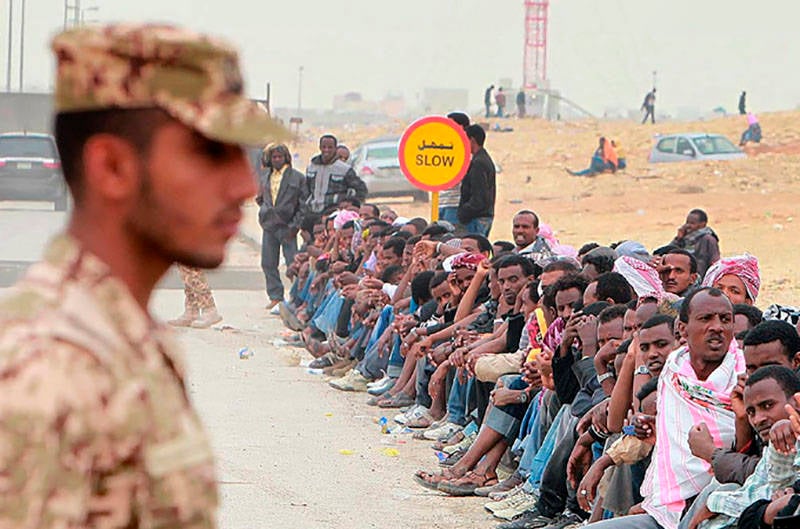
Thus, during 2013, more than 160 of thousands of illegal foreign migrants were expelled from the country, among whom were citizens of Ethiopia. It was with the Ethiopian citizens that the Saudi police linked the commission of a large part of the violent crimes in the country. The criminality of people from African countries is explained by their low social status even in the migrant environment, the lack of education and normal qualifications. Often immigrants from African countries, arriving in Saudi Arabia illegally, cannot find a job and become either on the criminal road or turn into beggars. In addition to 160, thousands of foreign citizens deported, over a million more illegal immigrants left the country voluntarily. About 800 thousands of migrants from Bangladesh, 300 thousands of Egyptian citizens, 200 thousands of Yemeni citizens, 140 thousands of Indian citizens, 50 thousands of Somali citizens departed from Saudi Arabia.
However, the measures taken by the Saudi authorities against migrants ultimately turned out to be a mass of problems for the country's economy and for the well-being of its residents - many small businesses were forced to close, a significant number of private and public institutions remained without lower-level workers, whose vacancies could not be filled by local residents . Many firms were forced to curtail their activities. And serious problems overtook not only private companies, initially focused on the use of migrant labor, but also government institutions. Thus, in Saudi Arabia, only 20% of health workers, despite all attempts by the country's leadership to “nationalize personnel,” are representatives of the local population. Immigrants from South and Southeast Asia comprise the majority of Saudi nurses, medical assistants, and other lower and middle health workers. Accordingly, the deportation of foreign migrants can have devastating consequences not only for private construction firms or domestic service agencies, but also for industrial enterprises and even healthcare facilities. Therefore, the Saudi authorities periodically conduct “amnesties” of illegal migrants. There is also an ambivalent relationship to immigrants from different states - for example, citizens of some countries can be deported from the country, others - no. So both Saudi Arabia and, to an even greater extent, the less populated countries of the Persian Gulf, are completely dependent on foreign labor.
Foreigners in the armed forces
A separate aspect of the problem under consideration is the presence of foreigners in the armed forces and law enforcement agencies of the countries of the Persian Gulf. Saudi Arabia, Qatar, Kuwait, Bahrain, Oman, the United Arab Emirates, until recently, were one of the few countries in the world that actively use foreign mercenaries to staff their own armed forces and law enforcement agencies. This was explained both by the need to attract highly skilled military specialists and by the monarchs' desire to use military units, whose fighters would not be related by kinship with the local population and, in the event of possible unrest or contradictions, would unconditionally follow command orders. In addition, not all the locals expressed a desire to enter the military service. The situation in the armed forces and police of the Persian Gulf countries up to the 1980-s. was almost similar to the current situation in various sectors of the economy. The highest command positions in the armed forces were occupied by representatives of local royal dynasties, but western military specialists, officers of the armed forces of Great Britain, could also be in command positions. Positions requiring special military knowledge were largely staffed by European officers. Command positions - officers from Arab countries. The personnel of the armed forces ethnically differed depending on the country.
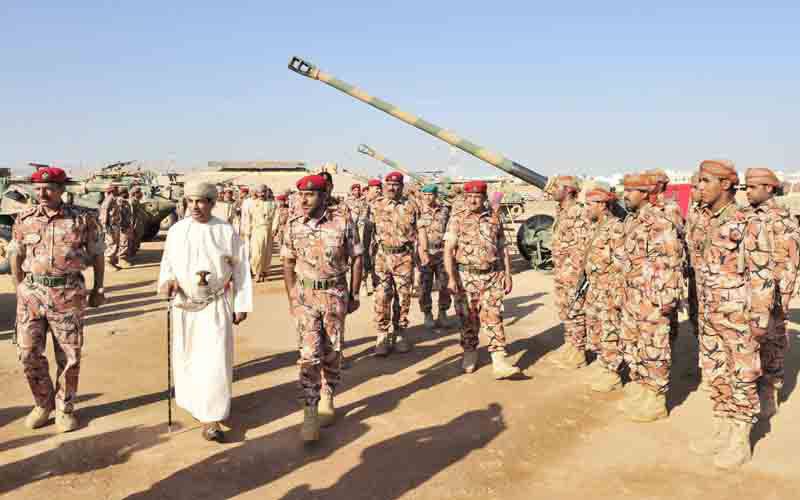
Thus, in Oman, the main part of the military were Baluchis - people from Southern Iran and Southern Pakistan, as well as Yemenis. English military instructors served in officer positions. In the UAE, the staff was staffed by Balochs, among the officers there were many Jordanian Arabs and Circassians. In Qatar, the personnel of the armed forces consisted mainly of Omani, Yemeni and Jordanian Arabs and Pakistanis. The Kuwaiti army recruited immigrants from Iran for military service. However, then most of the Gulf countries embarked on a policy of "nationalization" of the armed forces. First of all, the decision to prohibit the service of foreigners in the armed forces was taken by Saudi Arabia, which, having a very large number of indigenous people by local standards, was able to staff military units with its own inhabitants.
However, the final rejection of the practice of using foreign military mercenaries and specialists in the countries of the Persian Gulf did not happen. They continue to serve American and British instructors, immigrants from South Asia. In Qatar, the armed forces are recruited by recruiting volunteers - male citizens of Qatar aged 17-25 who profess Islam. However, the law provides for the possibility of serving foreign citizens in the Qatari army under special contracts. In addition to the armed forces, there are security forces in Qatar, which are still recruited through the hiring of Yemenis, Omanis and Baluchis. In the United Arab Emirates, in addition to the armed forces, also officially recruited by local residents, the services of a battalion of foreign mercenaries of up to 800 people - former soldiers of the Colombian, South African armies, and the French Foreign Legion are used.
The programs of nationalization of the armed forces in the Gulf countries were caused by the need to secure the current political regimes not from clan conflicts among the indigenous population, but from the enormous growth of migrants in the general population structure. Currently, the tasks of strengthening their own armed forces are considered by the governments of most Gulf countries to be among the highest priorities. This is due to the fact that the relict states of the Arabian Peninsula are in a state of inevitable social and political transformations. The so-called “Arab Spring”, inspired by the special services of the monarchies of the Persian Gulf, behind which the USA stood, destroyed most of the strong secular regimes in the Arab world - Egyptian, Libyan, Tunisian, plunged Syria into the abyss of civil war. In fact, the processes of destruction of states in the Middle East began much earlier - from the moment of the American aggression against Iraq and the actual destruction of Iraq as a single state entity, followed by the chaotic internal political situation on its territory.
The Arab Spring catalyzed these processes and entailed what is happening in the Middle East today — the onset of the Islamic Caliphate, the civil war in Syria and Iraq, the general increase in political instability in the region. It is likely that in the foreseeable future the situation in the countries of the Persian Gulf will be destabilized. The presence of a large mass of migrants makes it particularly problematic for possible political transformations in the countries in question. Firstly, the vast masses of migrants can become a practically inexhaustible resource for protest actions, riots, and, if necessary, terrorist attacks or the formation of rebel units. Secondly, in the event of the collapse of monarchical regimes and the transition of these states to republican rule, it will be enough for migrants to acquire citizenship, as they will make up the relative or absolute majority of voters in the Arab countries of the Gulf and then the latter will practically cease to be Arabic. Therefore, for the countries of the Persian Gulf, the presence of such a significant number of foreign migrants has long become a serious internal social problem, which, together with a number of other problems and contradictions, will sooner or later be felt.
Information